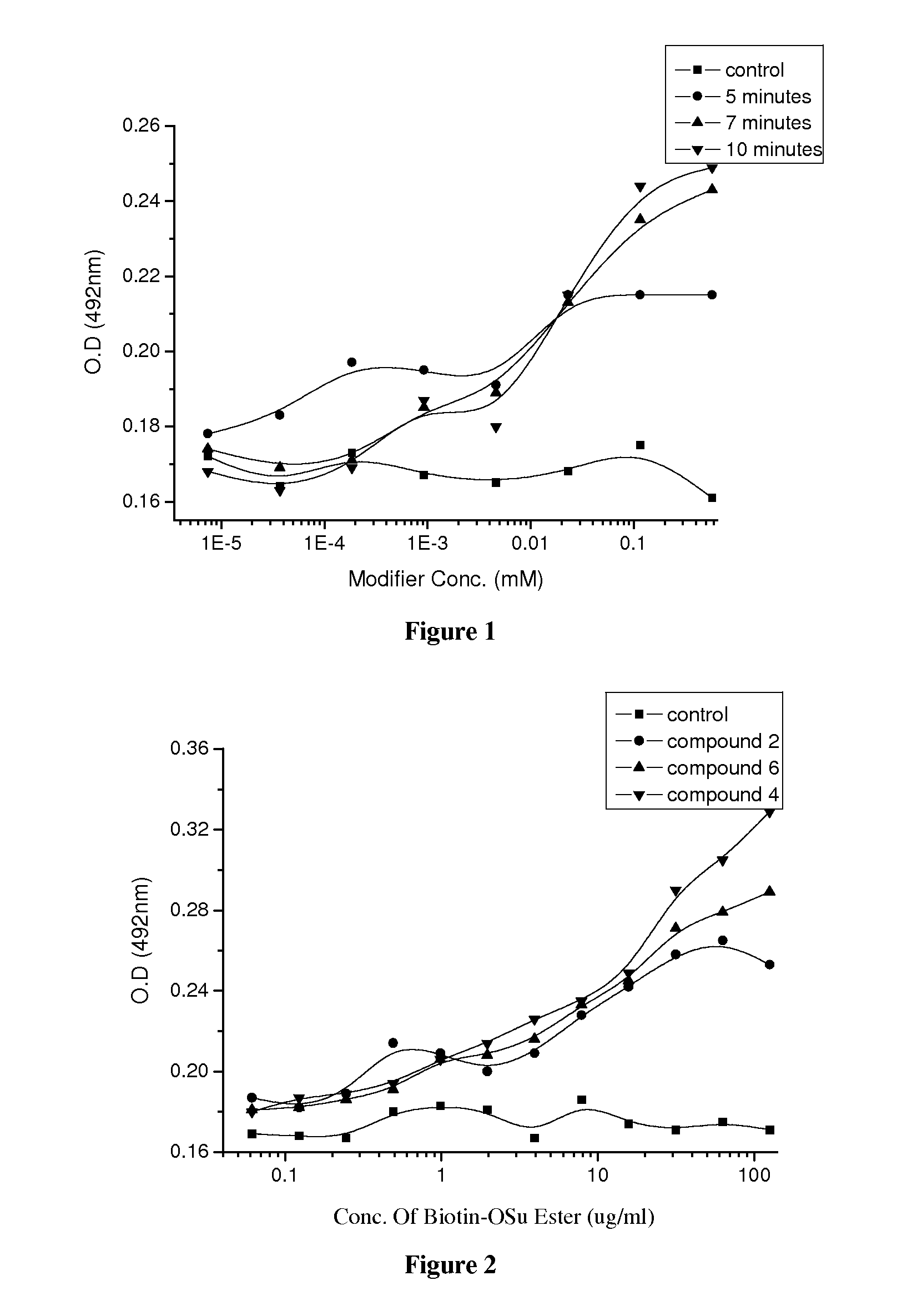Method of ultraviolet light assisted surface modification and product having a surface formed by this method
a technology of ultraviolet light and surface modification, which is applied in the field of surface modification, can solve the problems of reducing the efficiency of surface modification, comparatively longer uv irradiation time, and extremely reactive substances, so as to improve the hydrophilicity of polymer materials on the surface, and prevent the formation of water drops
- Summary
- Abstract
- Description
- Claims
- Application Information
AI Technical Summary
Benefits of technology
Problems solved by technology
Method used
Image
Examples
example 2
[0152]Dissolving compound 2, 4, 6, 7 into pure water (conductivity=0.8 μs / cm) to prepare 0.05 mM solution. Dissolving 2-XTC, benzophenone into anhydrous ethanol to prepare a 0.064 mM solution and a 0.053 mM solution respectively. Using UV-vis Spectrograph (GBC Cintra20, Australia) to measure the UV spectra of the six solutions described above in a wavelength range of 190-400 nm. Table 1 shows the characteristic absorption wavelength (λmax) and molar absorption coefficient of light (ε) of the six compounds.
[0153]
TABLE 1Ultraviolet absorption of the six compoundscompound 2compound 4compound 6compound 72-XTCBPλmax (nm)201.5202.3—194.8——ε (L · mol−1 · cm−1)2000025017—40427——λmax (nm)219.4217.7——220.7216.1ε (L · mol−1 · cm−1)1569017759——780421937λmax (nm)260.4260.4248.8248.6256.6261.8ε (L · mol−1 · cm−1)442594567243882446302515819390λmax (nm)353.0353.4341.6342.5345.0—ε (L · mol−1 · cm−1)49835224486952642940—
example 3
[0154]Dissolving compound 6 in distilled water to prepare a solution with the initial concentration at 0.58 mM, and five-fold dilute to prepare a series of modification solution based on the above concentration. Before use, each concentration of solution is passed with nitrogen gas to remove oxygen. Washing a surface-unmodified polystyrene (PS) 96 well plate with anhydrous ethanol and deionized water three times respectively, drying it at 50° C. for 45 minutes for future use. Adding the modification solution above into each well of the plate in an amount of 100 μL / well, placing the plate under a 1000 W high-pressure mercury lamp for irradiation with the light intensity at 3.55 mW / cm2 (λ=254 nm) and duration at 5, 7 and 10 minutes respectively. After irradiation, pouring the modification solution out, washing the plate with deionized water three times, and then drying it at 50° C. for 45 minutes, protect from light for future use. Adding 3.94 μg / mL biotin-OSu ester solution (pH=7.2 p...
example 4
[0155]Dissolving compounds 2, 4, and 6 in distilled water to prepare 0.1 mM modification solutions. The oxygen removal operation of modification solution and pre-treatment of surface-unmodified PS 96 well plate are the same as those of example 3. Adding the above three modification solutions into each well of the plate (100 μL / well), and the irradiation and post-treatment are also the same as those of example 3. Preparing a biotin-OSu ester (pH=7.2 PBS as solvent) solution with concentration of 126 μg / mL, two-fold dilute to obtain a series of solutions, adding each concentration of solution into the compound 2, 4, 6 modified well respectively, and the subsequent wash, avidin adsorption, chromogenic reaction and absorption measurement are also the same as those of example 3. The results are shown in FIG. 2. It is found that compound 4 has the best modification effect on PS well plate, and compound 6 and compound 2 exhibit comparatively poorer modification effect.
PUM
| Property | Measurement | Unit |
|---|---|---|
| length | aaaaa | aaaaa |
| length | aaaaa | aaaaa |
| mass fraction | aaaaa | aaaaa |
Abstract
Description
Claims
Application Information
 Login to View More
Login to View More - R&D
- Intellectual Property
- Life Sciences
- Materials
- Tech Scout
- Unparalleled Data Quality
- Higher Quality Content
- 60% Fewer Hallucinations
Browse by: Latest US Patents, China's latest patents, Technical Efficacy Thesaurus, Application Domain, Technology Topic, Popular Technical Reports.
© 2025 PatSnap. All rights reserved.Legal|Privacy policy|Modern Slavery Act Transparency Statement|Sitemap|About US| Contact US: help@patsnap.com



